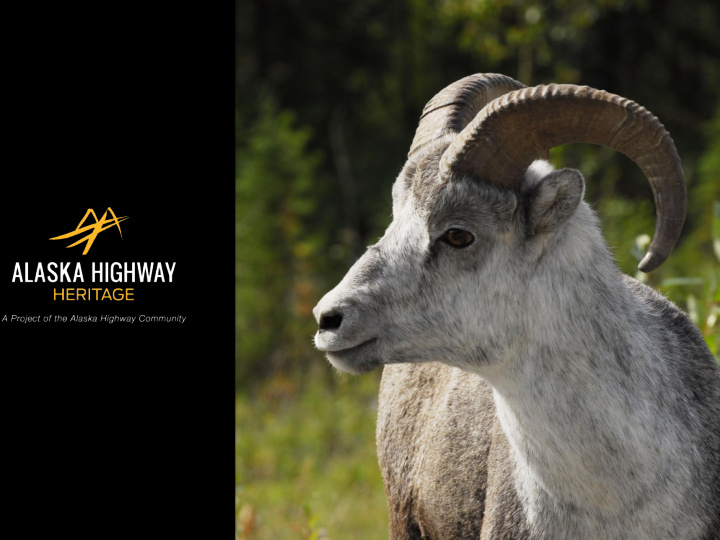



Are We There Yet? Building the Case for the Alaska Highway Corridor April Moi │ Northern British Columbia Tourism Association Julie Harris │ Contentworks Inc.
Are We There Yet? Building the Case for the Alaska Highway Corridor April Moi │ Northern British Columbia Tourism Association Julie Harris │ Contentworks Inc.
An Icon
The Destination Vision (Untested Working Draft) The Alaska Highway Corridor is a valued and dynamic legacy that contributes to our sense of identity and our relationship with the natural world, creates an understanding of our past, is used to build communities in the present, and informs our choices for the future. Components Stories A sense of place Involving people Making heritage relevant Sustaining links between heritage and other parts of regional life – tourism, nature, learning, and recreation
Orientation
Situating the Alaska Highway Corridor Passes through prairies, rivers, mountains and muskeg 2,232 km from Dawson Creek to Fairbanks 1,1916 km in BC and Yukon
Regional History Thousands of years of use and occupancy Long fur-trade history Klondike Gold Rush, 1897 – 1899 Treaty Eight, 1899-1921 Treaty Eleven, 1921
Regional History First Nation traders and community builders Northern air services World War II Wage economy Oil and gas development Kluane National Park Yukon Umbrella Final Agreement (with FNs)
Alaska Highway Chronology P LANNING “F RIENDLY ” INVASION : P UBLIC R OADS R OADS AND A IR M ARCH 1942 A DMINISTRATION : D EVELOPING THE R OUTES : 1897- 1942-1943 P IONEER R OAD : A LASKA H IGHWAY : 1940 M ARCH TO O CTOBER ONGOING A GREEMENT : C ANADA TAKES 1942 F EBRUARY CONTROL : A PRIL 1942 1946
On View Nature Vistas Historic buildings Archaeological sites Spiritual places Gathering places Bridges Camp sites Old roads and new roads Extraction sites
Starting the Journey
Studying the Map
Building Relationships
Detour
Crossing a Bridge
Fueling Up Seek formal recognition of the Alaska Highway as a National Historic Site of Canada Create a common language among partners and across jurisdications (Yukon, BC, local governments and First Nations) Join a respected national brand Link cultural and natural heritage Gain access to Parks Canada expertise and experience
Getting There
Year 1 – Taking Stock Communicated intentions Identified knowledge- keepers, themes and resources Shared perspectives and encouraged participation Updated information base
Year 2 – Listen and Understand Consult Understand concerns and expectations Map stories and places of cultural and heritage value Describe values Propose governance model
Year 3 – Negotiate and Commit Consult some more Set out a strategic multi- year plan with integrated goals for heritage, tourism and development Work with land holders and governments on conservation frameworks Confirm funding model Submit the NHSC nomination
Thoughts, Sites and Sounds from Year 1
Intersecting and Overlapping Cultural Landscapes Aboriginal Living, evolved Associative Resources exist at various scales and forms Ideas, experiences and beliefs matter
Intersecting and Overlapping Cultural Landscapes
Intersecting and Overlapping Cultural Landscapes
Positives
Negatives
Threats
Top Heritage Issues History (knowledge, places and understanding) is being lost Heritage and culture are tightly linked All groups – including elders, youth and First Nations – need to be engaged in: Telling stories Identifying places of value Setting priorities for conservation and interpretation More commitment is needed from owners to protect and interpret the corridor ’ s highway history
Top Regional Issues The Alaska Highway helps sustain the regional economy Heritage should be leveraged to encourage visitors to stay longer More heritage and cultural opportunities are needed for residents Heritage can diversity employment opportunities Don’t i nterference in the operation of the highway
Good News NENAS Storytelling Project
Good News Taylor Memory Project
Looking Ahead
Can we get there? Assessment categories from “Community -Based Heritage Management: A Case Study and Agenda for Research” by Andrew Hodges and Steve Watson (2000) Critical mass Managerial competence and Existing organizations organizational skill Socio-demographic profile Consensus Ownership Expresses interest in heritage The site Network management Threat and cause Inclusiveness Leadership
Bottom Line Yes, because The cultural landscape is authentic and meaningful The entire region is seeking options to diversify employment, create a stronger identify, strengthen the tourism sector, and enhance cultural offerings Higher-level governments have offered support and want the project to succeed
Bottom Line But Local governments need more exposure to the benefits of heritage activities Public needs more opportunities to understand the value of heritage resources Stronger links with cultural activities must be developed Governance needs a hybrid approach: Strong leadership and Shared responsibilities Property owners (Fed, BC, Yukon, FNs, local govts, private, museums) must be onside
Thank you Julie Harris – jharris@contentworks.ca April Moi – april@nbctourism.com
Recommend
More recommend